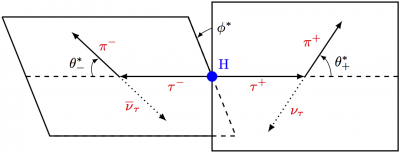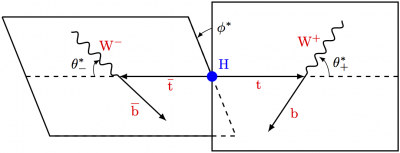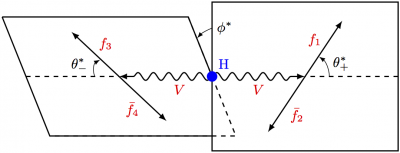User Tools
latex:tikz:decay_planes
Example of drawing decay planes with LaTeX using the TikZ package. For more, please visit https://tikz.net/category/physics/particle-physics/.
- decay_planes.tex
% Author: Izaak Neutelings (June, 2017) % model diagram: https://arxiv.org/abs/hep-ph/0503172 % boson/wiggle/snake: https://tex.stackexchange.com/questions/68890/how-can-i-draw-snake-arrow-in-automata-using-tikz \documentclass{article} \usepackage{tikz} \usepackage{tikz-3dplot} \tikzset{>=latex} % for LaTeX arrow head \usetikzlibrary{decorations.pathmorphing} % for snake % split figures into pages \usepackage[active,tightpage]{preview} \PreviewEnvironment{tikzpicture} \setlength\PreviewBorder{1pt}% \begin{document} % PA________________PB % QA________________QB _| | % \ F3 \/ | F1 | % \ \ \ | / | % \ ( \ \| / ) | % \--------\<--------o-------->/--------+ % \ \ |\ / | % \ \ | \ / | % \ F4 | \ F2 | % QD_____________|_QC | % PD________________PC % % FALSE PERSPECTIVE - Higgs to top quark pair \small \tdplotsetmaincoords{90}{90} % look straight at yz plane \begin{tikzpicture}[tdplot_main_coords,scale=0.85] \def\W{5} \def\w{2.5} \def\R{0.65} \coordinate (A) at (0,-\W, 0); \coordinate (O) at (0, 0, 0); \coordinate (B) at (0, \W, 0); \coordinate (P1) at (0, 0, 2); \coordinate (P2) at (0, \W, 2); \coordinate (P3) at (0, \W, -2); \coordinate (P4) at (0, 0, -2); \coordinate (P0) at (0, \w, 0); \coordinate (F1) at (0,3.5, 1.5); \coordinate (F2) at (0,1.5,-1.5); \coordinate (phi) at (0,0,1.3); \begin{scope}[xslant=-0.4,yscale=0.8] \coordinate (Q1) at (0, -\W, 2); \coordinate (Q2) at (0, 0, 2); \coordinate (Q3) at (0, 0, -2); \coordinate (Q4) at (0, -\W, -2); \coordinate (Q0) at (0, -\w, 0); \coordinate (F3) at (0,-3.3, 1.5); \coordinate (F4) at (0,-1.7,-1.5); \end{scope} % plane 2 \draw[thick] (Q1) %node at (Q1) {Q1} -- (Q2) %node at (Q2) {Q2} -- (Q3) %node at (Q3) {Q3} -- (Q4) %node at (Q4) {Q4} -- (Q1); % plane 1 - filled white \fill[color=white,thick,draw=black] (P1) -- (P2) -- (P3) -- (P4) -- cycle; % plane 2 - dashes corner \begin{scope} \clip (P1) -- (P2) -- (P3) -- (P4) -- cycle; \draw[dashed,thick] (Q2) -- (Q3) -- (Q4); \end{scope} % axis and arrows \draw[dashed,thick] (A) -- (Q0); \draw[dashed,thick] (B) -- (P0); \draw[thick,->] (O) -- node[red,below=-1pt] {t} (P0); \draw[thick,->] (O) -- node[red,below right=-2pt] {$\overline{\textrm{t}}$} (Q0); \draw[thick,decorate,decoration={snake}] % ,post length=0mm (F1) -- node[red,above left=-2pt] {W$^+$} (P0); \draw[thick,->] (P0) -- node[red,below right=-1pt] {b} (F2); \draw[thick,decorate,decoration={snake,post length=0mm}] (F3) -- node[red,above right=-1pt] {W$^-$} (Q0); \draw[thick,->] (Q0) -- node[red,below left=-1pt] {$\overline{\textrm{b}}$} (F4); % dots \fill[blue] (O) circle [radius=4pt]; \node [above=8pt,right=1pt,blue] at (O) {H}; % needs extra package %\fill (P0) circle [radius=2pt]; %\fill (Q0) circle [radius=2pt]; % angles \draw[canvas is yz plane at x=0,rotate around z=20,->] (phi) arc [start angle=90,end angle=118,radius=1] node at (phi) [right=0pt] {$\phi^*$}; \draw[canvas is yz plane at x=0,->] (P0)+(\R,0,0) arc [start angle=0,end angle=55,radius=\R] node[midway,above=1pt,right=1pt] {$\theta^*_+$}; \draw[canvas is yz plane at x=0,xslant=-0.4,yscale=0.8,->] (Q0)+(-\R,0,0) arc [start angle=180,end angle=120,radius=\R] node[midway,above=1pt,left=1pt] {$\theta^*_-$}; \end{tikzpicture} % FALSE PERSPECTIVE - Higgs to top quark pair \small \tdplotsetmaincoords{90}{90} % look straight at yz plane \begin{tikzpicture}[tdplot_main_coords,scale=0.85] \def\W{5} \def\w{2.5} \def\R{0.65} \coordinate (A) at (0,-\W, 0); \coordinate (O) at (0, 0, 0); \coordinate (B) at (0, \W, 0); \coordinate (P1) at (0, 0, 2); \coordinate (P2) at (0, \W, 2); \coordinate (P3) at (0, \W, -2); \coordinate (P4) at (0, 0, -2); \coordinate (P0) at (0, \w, 0); \coordinate (F1) at (0,3.5, 1.5); \coordinate (F2) at (0,1.5,-1.5); \coordinate (phi) at (0,0,1.3); \begin{scope}[xslant=-0.4,yscale=0.8] \coordinate (Q1) at (0, -\W, 2); \coordinate (Q2) at (0, 0, 2); \coordinate (Q3) at (0, 0, -2); \coordinate (Q4) at (0, -\W, -2); \coordinate (Q0) at (0, -\w, 0); \coordinate (F3) at (0,-3.3, 1.5); \coordinate (F4) at (0,-1.7,-1.5); \end{scope} % plane 2 \draw[thick] (Q1) %node at (Q1) {Q1} -- (Q2) %node at (Q2) {Q2} -- (Q3) %node at (Q3) {Q3} -- (Q4) %node at (Q4) {Q4} -- (Q1); % plane 1 - filled white \fill[color=white,thick,draw=black] (P1) -- (P2) -- (P3) -- (P4) -- cycle; % plane 2 - dashes corner \begin{scope} \clip (P1) -- (P2) -- (P3) -- (P4) -- cycle; \draw[dashed,thick] (Q2) -- (Q3) -- (Q4); \end{scope} % axis and arrows \draw[dashed,thick] (A) -- (Q0); \draw[dashed,thick] (B) -- (P0); \draw[thick,->,decorate,decoration={snake,post length=5}] (O) -- node[red,below=2pt] {$V$} (P0); \draw[thick,->,decorate,decoration={snake,post length=5}] (O) -- node[red,below right=2pt] {$V$} (Q0); \draw[thick,->] % ,post length=0mm (P0) -- node[red,above left=-2pt] {$f_1$} (F1); \draw[thick,->] (P0) -- node[red,below right=-1pt] {$\bar{f_2}$} (F2); \draw[thick,->] (Q0) -- node[red,above right=-1pt] {$f_3$} (F3); \draw[thick,->] (Q0) -- node[red,below left=-1pt] {$\bar{f_4}$} (F4); % dots \fill[blue] (O) circle [radius=4pt]; \node [above=8pt,right=1pt,blue] at (O) {H}; % needs extra package %\fill (P0) circle [radius=2pt]; %\fill (Q0) circle [radius=2pt]; % angles \draw[canvas is yz plane at x=0,rotate around z=20,->] (phi) arc [start angle=90,end angle=118,radius=1] node at (phi) [right=0pt] {$\phi^*$}; \draw[canvas is yz plane at x=0,->] (P0)+(\R,0,0) arc [start angle=0,end angle=55,radius=\R] node[midway,above=1pt,right=1pt] {$\theta^*_+$}; \draw[canvas is yz plane at x=0,xslant=-0.4,yscale=0.8,->] (Q0)+(-\R,0,0) arc [start angle=180,end angle=120,radius=\R] node[midway,above=1pt,left=1pt] {$\theta^*_-$}; \end{tikzpicture} \end{document}
latex/tikz/decay_planes.txt · Last modified: by iwn




